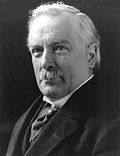Boundaries
The constituency names, in this section, follow the format and the spelling used by F. W. S. Craig in his British Parliamentary Election Results series. Variations may be found in other sources.
Caernarvon 1536–1832
On the basis of information from several volumes of the History of Parliament, it is apparent that the history of the borough representation from Wales and Monmouthshire is more complicated than that of the English boroughs.
The Laws in Wales Act 1535 (26 Hen. 8. c. 26) provided for a single borough seat for each of 11 of the 12 Welsh counties and Monmouthshire. The legislation, which was passed in 1536 (using the modern civil year starting on 1 January), was ambiguous as to which communities were enfranchised. The county towns were awarded a seat, but this in some fashion represented all the ancient boroughs of the county, as the others were required to contribute to the member's wages. It is not clear if the burgesses of the contributing boroughs could vote. The only election under the original scheme was for the 1542 parliament. It seems that only burgesses from the county towns actually took part. The Parliament Act 1543 (35 Hen. 8. c. 11) confirmed that the contributing boroughs could send representatives to take part in the election at the county town. As far as can be told from surviving indentures of returns, the degree to which the out boroughs participated varied, but by the end of the 16th century all the seats had some participation from them at some elections at least.
The original scheme was modified by later legislation and decisions of the House of Commons, which were sometimes made with no regard to precedent or evidence: for example in 1728 it was decided that only the freemen of the borough of Montgomery could participate in the election for that seat, thus disenfranchising the freemen of Llanidloes, Welshpool and Llanfyllin.
In the case of Caernarvonshire (now Caernarfonshire), the county town was Caernarvon (now known as Caernarfon). The out boroughs were Conway (now Conwy), Criccieth (or Cricieth), Nevin (now known as Nefyn), and Pwllheli. The freemen of the five boroughs were entitled to vote. In the 1715–1754 period there were estimated to be about 1,600 freemen, of whom about 1,200 were non-resident. Later in the 18th century the estimated electorate was about 1,000 freemen.
Caernarvon Boroughs 1832–1950
The Caernarvon Boroughs was a district of boroughs constituency, which grouped a number of parliamentary boroughs in Caernarvonshire into one single member constituency. The voters in each participating borough cast ballots, which were added together over the whole district to decide the result of the poll. The enfranchised communities in this district, from 1832, were the six boroughs of Caernarvon, Bangor, Conway, Criccieth, Nevin, and Pwllheli.
The exact boundaries of the parliamentary boroughs in the district were altered by the Boundary Act 1868, but the general nature of the constituency was unchanged. There were no further boundary changes in the 1885 redistribution of parliamentary seats.
In 1918 the constituency was redefined, to include the then local government areas of the Municipal Boroughs of Bangor, Caernarvon, Conway, and Pwllheli; the Urban Districts of Criccieth, Llandudno, Llanfairfechan and Penmaenmawr, as well as the parish of Nevin.
From 1918 to 1950 the administrative county of Caernarvonshire was divided into two seats: Caernarvon Boroughs and a Caernarvonshire county constituency. The territory of the borough seat was enclaved within the county constituency. Different local authorities, included in the borough constituency, were not necessarily adjoining.
Caernarvon 1950–1983
The redistribution, which took effect in 1950, created two Caernarvonshire county divisions – Caernarvon in the south-western two thirds of the county and Conway (later spelt Conwy) in the north-eastern third. The new divisions included territory which had come from both of the two old seats.
The local authorities, whose territories were combined to form the constituency in 1950, were the Municipal Boroughs of Caernarvon, and Pwllheli; the Urban Districts of Criccieth, and Portmadoc; as well as the Rural Districts of Gwyrfai and Lleyn. This arrangement was not altered by the redistribution which took effect in February 1974, which was based on the pre-1974 local government boundaries.
From 1 April 1974, a new pattern of counties was created in Wales. This constituency became part of the county of Gwynedd.
Caernarfon from 1983
In the redistribution of 1983, the spelling of the official name of the constituency was changed. The constituency boundary was unchanged, but it was redefined in terms of the local authorities created in 1974. It comprised the Borough of Arfon wards numbered 8 to 12 and 16 to 29, together with the District of Dwyfor.
In 1996 Welsh local government was again reorganised. Arfon and Dwyfor became part of a Gwynedd unitary authority.
The Parliamentary Constituencies (Wales) Order 1995, based on the pre-1996 local authority areas, came into effect in 1997. It defined this constituency as:-
(i) The following wards of the Borough of Arfon, namely, Bethel, Bontnewydd, Cadnant, Deiniolen, Llanberis, Llandwrog, Llanllyfni, Llanrug, Llanwnda, Menai (Caernarfon), Peb-lig, Penisarwaun, Penygroes, Seiont, Talysarn, Waunfawr and Y Felinheli; and
(ii) the District of Dwyfor.
Following radical boundary changes undertaken by the Boundary Commission for Wales, this seat was abolished in time for the general election in 2010, replaced by Arfon and part of Dwyfor Meirionnydd.





